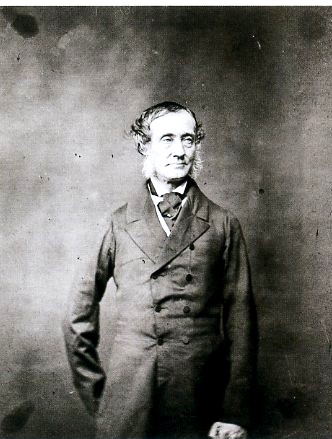Alcock
Alcock's Canal refers to a structure within the human anatomy named after the British anatomist Benjamin Alcock who described it in the 19th century. It is also known as the pudendal canal, highlighting its significance in containing and protecting the pudendal nerve, as well as the internal pudendal vessels. This anatomical feature plays a crucial role in the pelvic region, influencing various physiological functions and potentially being involved in certain medical conditions.
Anatomy[edit | edit source]
Alcock's Canal is a sheath of fascia located in the lateral wall of the ischioanal fossa, a space in the deep perineum. It is formed by the splitting of the obturator fascia, and it runs along the internal part of the ischium, a bone of the pelvis. The canal serves as a protective passageway for the pudendal nerve and the internal pudendal vessels, which include the internal pudendal artery and vein. These structures exit the pelvis through the greater sciatic foramen, curve around the ischial spine, and enter the perineum through the lesser sciatic foramen, at which point they enter Alcock's Canal.
Function[edit | edit source]
The primary function of Alcock's Canal is to protect and support the pudendal nerve and internal pudendal vessels in their course through the pelvis and into the perineum. The pudendal nerve is responsible for providing sensory and motor innervation to various structures in the pelvic region, including the external genitalia, the anus, and parts of the urethra and bladder. Therefore, the integrity of Alcock's Canal is vital for maintaining normal pelvic and perineal function.
Clinical Significance[edit | edit source]
Damage or compression of the pudendal nerve within Alcock's Canal can lead to a condition known as pudendal neuralgia, characterized by chronic pelvic pain, especially in the genital area or the anus. This condition can significantly affect the quality of life and may arise due to various causes, including trauma, childbirth, or surgery. Diagnosis and treatment of pudendal neuralgia often involve a multidisciplinary approach, including nerve blocks, physical therapy, and, in some cases, surgical decompression of the nerve.
See Also[edit | edit source]
Transform your life with W8MD's budget GLP1 injections from $125
W8MD offers a medical weight loss program NYC and a clinic to lose weight in Philadelphia. Our W8MD's physician supervised medical weight loss centers in NYC provides expert medical guidance, and offers telemedicine options for convenience.
Why choose W8MD?
- Comprehensive care with FDA-approved weight loss medications including:
- loss injections in NYC both generic and brand names:
- weight loss medications including Phentermine, Qsymia, Diethylpropion etc.
- Accept most insurances for visits or discounted self pay cost.
- Generic weight loss injections starting from just $125.00 for the starting dose
- In person weight loss NYC and telemedicine medical weight loss options in New York city available
- Budget GLP1 weight loss injections in NYC starting from $125.00 biweekly with insurance!
Book Your Appointment
Start your NYC weight loss journey today at our NYC medical weight loss, and Philadelphia medical weight loss Call (718)946-5500 for NY and 215 676 2334 for PA
Search WikiMD
Ad.Tired of being Overweight? Try W8MD's NYC physician weight loss.
Semaglutide (Ozempic / Wegovy and Tirzepatide (Mounjaro / Zepbound) available. Call 718 946 5500.
Advertise on WikiMD
|
WikiMD's Wellness Encyclopedia |
| Let Food Be Thy Medicine Medicine Thy Food - Hippocrates |
Translate this page: - East Asian
中文,
日本,
한국어,
South Asian
हिन्दी,
தமிழ்,
తెలుగు,
Urdu,
ಕನ್ನಡ,
Southeast Asian
Indonesian,
Vietnamese,
Thai,
မြန်မာဘာသာ,
বাংলা
European
español,
Deutsch,
français,
Greek,
português do Brasil,
polski,
română,
русский,
Nederlands,
norsk,
svenska,
suomi,
Italian
Middle Eastern & African
عربى,
Turkish,
Persian,
Hebrew,
Afrikaans,
isiZulu,
Kiswahili,
Other
Bulgarian,
Hungarian,
Czech,
Swedish,
മലയാളം,
मराठी,
ਪੰਜਾਬੀ,
ગુજરાતી,
Portuguese,
Ukrainian
Medical Disclaimer: WikiMD is not a substitute for professional medical advice. The information on WikiMD is provided as an information resource only, may be incorrect, outdated or misleading, and is not to be used or relied on for any diagnostic or treatment purposes. Please consult your health care provider before making any healthcare decisions or for guidance about a specific medical condition. WikiMD expressly disclaims responsibility, and shall have no liability, for any damages, loss, injury, or liability whatsoever suffered as a result of your reliance on the information contained in this site. By visiting this site you agree to the foregoing terms and conditions, which may from time to time be changed or supplemented by WikiMD. If you do not agree to the foregoing terms and conditions, you should not enter or use this site. See full disclaimer.
Credits:Most images are courtesy of Wikimedia commons, and templates, categories Wikipedia, licensed under CC BY SA or similar.
Contributors: Prab R. Tumpati, MD



